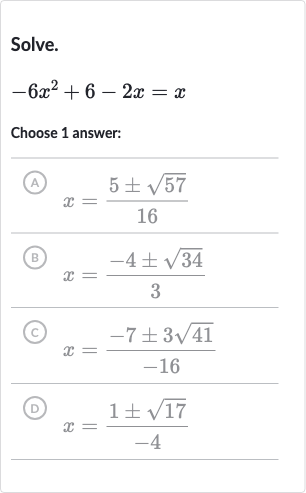AI tutor
Full solution
Q. Solve.Choose answer:(A) (B) (C) (D)
- Identify Quadratic Equation: Now we have a quadratic equation in the form , where , , and . We can solve this using the quadratic formula, .
- Calculate Discriminant: Let's calculate the discriminant first.Discriminant = Discriminant = Discriminant = Discriminant =
- Apply Quadratic Formula: Now we can plug the values of , , and the discriminant into the quadratic formula.
- Simplify Square Root: Simplify the square root of the discriminant if possible. Since is not a perfect square, we leave it as .
- Simplify Fraction: Now we need to simplify the fraction by dividing the numerator by the denominator.
- Simplify Second Term: We can simplify the second term by dividing by .
- Write Possible Solutions: We can now write the two possible solutions for . or
- Find Common Denominator: To match the answer choices, we need to find a common denominator for the two terms in each solution. or or
- Match Answer Choices: Now we can see that the solutions match one of the answer choices. or This corresponds to answer choice (D) if we simplify to and take out a factor of from the square root. However, this simplification is incorrect because cannot be simplified to as is not a multiple of . Therefore, we have made a math error.
More problems from Solve a quadratic equation using the quadratic formula
QuestionGet tutor help
QuestionGet tutor help
QuestionGet tutor help
QuestionGet tutor help
QuestionGet tutor help
QuestionGet tutor help
QuestionGet tutor help
QuestionGet tutor help

